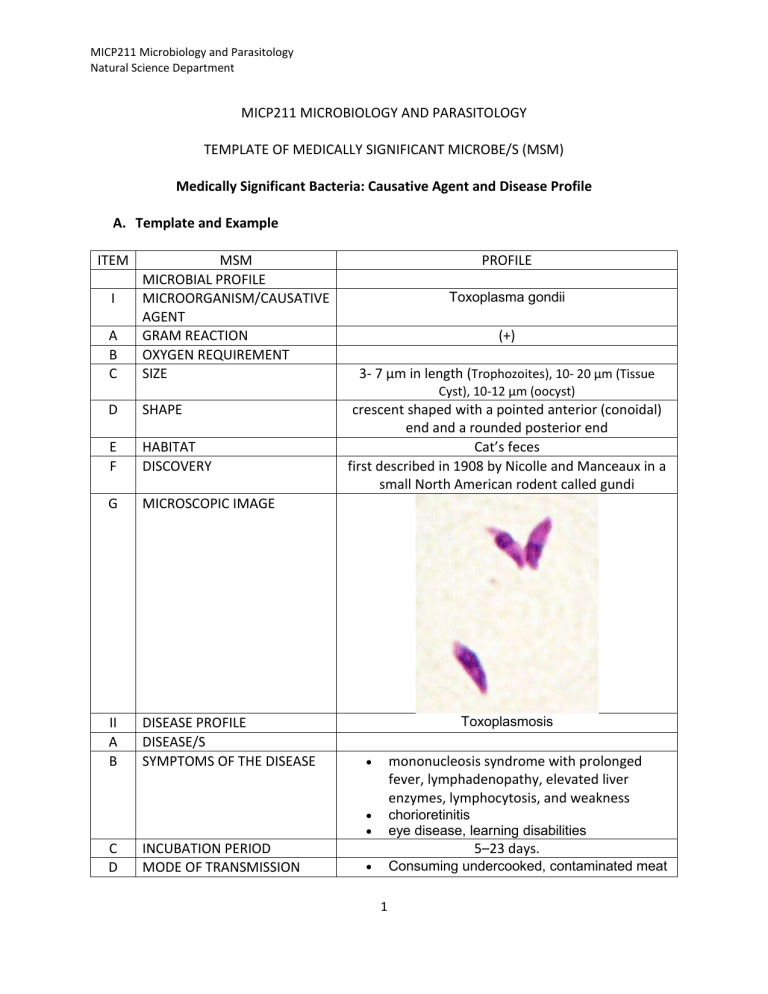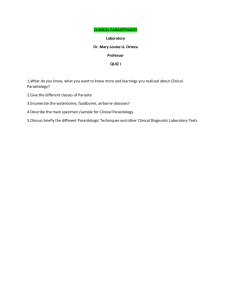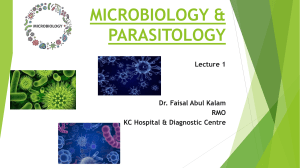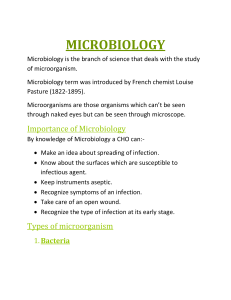
MICP211 Microbiology and Parasitology Natural Science Department MICP211 MICROBIOLOGY AND PARASITOLOGY TEMPLATE OF MEDICALLY SIGNIFICANT MICROBE/S (MSM) Medically Significant Bacteria: Causative Agent and Disease Profile A. Template and Example ITEM I A B C MSM MICROBIAL PROFILE MICROORGANISM/CAUSATIVE AGENT GRAM REACTION OXYGEN REQUIREMENT SIZE PROFILE Toxoplasma gondii (+) 3- 7 µm in length (Trophozoites), 10- 20 µm (Tissue Cyst), 10-12 µm (oocyst) D SHAPE E F HABITAT DISCOVERY G MICROSCOPIC IMAGE II A B DISEASE PROFILE DISEASE/S SYMPTOMS OF THE DISEASE C D INCUBATION PERIOD MODE OF TRANSMISSION crescent shaped with a pointed anterior (conoidal) end and a rounded posterior end Cat’s feces first described in 1908 by Nicolle and Manceaux in a small North American rodent called gundi Toxoplasmosis mononucleosis syndrome with prolonged fever, lymphadenopathy, elevated liver enzymes, lymphocytosis, and weakness chorioretinitis eye disease, learning disabilities Consuming undercooked, contaminated meat 5–23 days. 1 MICP211 Microbiology and Parasitology Natural Science Department Eating food that is prepared by contaminated kitchen equipment that have had contact with raw, contaminated meat Drinking water contaminated with Toxoplasma gondii Mother-to-child (congenital) transmission. Receiving contaminated blood transfusions or organ transplants (Rare) ingesting the parasite unintentionally after coming into contact with cat feces that carry Toxoplasma gondii E DIAGNOSIS • Tests for detecting IgG antibody include: Enzyme-linked immunosorbent assay (ELISA) Sabin-Feldman dye test Indirect fluorescent antibody test (!FAT) Latex agglutination test Magnetic resonance imaging (MRl) and computed tomography (CT) Polymerase chain reaction (PCR) F TREATMENT G PREVENTION Pyrimethamine and sulfadiazine (add folinic acid in an immunosuppressed host) Spiramycin Rinse fresh fruits and vegetables under running water. Use a food thermometer to ensure foods are cooked to a safe internal temperature Wear gloves when gardening and during any contact with soil or sand because it might be contaminated with cat feces that contain Toxoplasma. Wash hands with soap and water after gardening or contact with soil or sand. Wash your utensils, cutting boards, and countertops with hot, soapy water after preparing each food item Wash hands with soap and water after cleaning out a cat’s litter box. Teach children the importance of washing hands to prevent infection. H NO OF DAYS BEING SYMPTOMATIC I IMAGE OF INFECTED PATIENT Most cases infection is asymptomatic 2 MICP211 Microbiology and Parasitology Natural Science Department 3 MICP211 Microbiology and Parasitology Natural Science Department ITEM MSM PROFILE MICROBIAL PROFILE I MICROORGANISM/CAUSATIVE AGENT A GRAM REACTION B OXYGEN REQUIREMENT C SIZE D SHAPE E HABITAT F DISCOVERY G MICROSCOPIC IMAGE II DISEASE PROFILE A DISEASE/S B SYMPTOMS OF THE DISEASE C INCUBATION PERIOD D MODE OF TRANSMISSION E DIAGNOSIS F TREATMENT G PREVENTION H NO OF DAYS BEING SYMPTOMATIC I IMAGE OF INFECTED PATIENT 4




